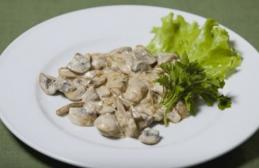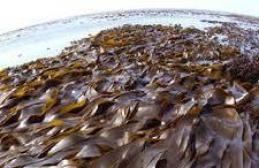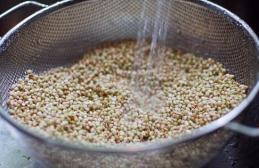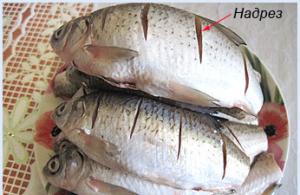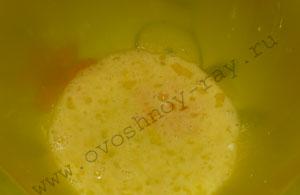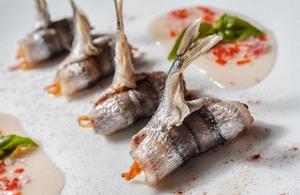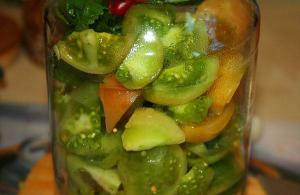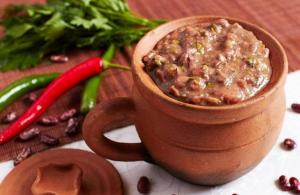Mackerel rolls can be classified as cold fish appetizers. Due to the fact that mackerel meat is quite fatty and tender, the roll hardens quickly, making it quite easy to prepare. However, the preparation for preparing any fish or meat rolls takes quite a lot of time, so they are considered more of a holiday dish than an everyday dish. The amazing and delicate taste of any cold appetizer makes it a desirable dish on our holiday table.
There are several methods for preparing mackerel rolls. Let's look at some of them.
Mackerel roll with gelatin and egg
Ingredients
- Two mackerel carcasses without heads and entrails. You can take any fresh or frozen fish, however, the dish with mackerel will be especially tasty;
- Fresh chicken egg – 2 pcs;
- Gelatin – 2 tbsp;
- Carrots – 1 piece;
- Spices for fish, bay leaf, salt, ground black pepper.
Cooking method
Boil the carrots in a separate saucepan, cool and peel. You can determine if carrots are ready by piercing them with a fork or small knife. Separately, hard boil the eggs.
Thaw and thoroughly wash the mackerel carcasses, remove the entrails and head if necessary. Using small cuts on the back of the fish, remove the spine and large bones, cut off the fins and tail. Salt the carcass, season with pepper, bay leaf and spices. Pour dry gelatin inside.
Peel the eggs and cut into thin slices with a sharp knife, cut the carrots into strips. Place eggs and carrots in layers along the fish carcass. After this, start rolling the fish roll. To keep it tight, tie it with thick twine and wrap it in food foil. In this case, eggs, carrots and gelatin should be inside the fish. Make sure that the roll is dense, but not so tight that the juice does not leak out during cooking.
Turn off the gas, remove the rolls and put them under a press for a day. The press can be a large stone or other weight. To save juice from the roll, keep the fish in a small saucepan. In this form, cool the rolls to room temperature, then put them in the refrigerator for 2-3 days so that the gelatin thickens. At the end, cut the fish with carrots and egg into thick slices. Can be served.
Pink salmon and mackerel roll

Ingredients
- Mackerel carcass – 4 pcs;
- Pink salmon fillet – 700 g;
- Lemon juice;
- Vegetable oil for greasing the baking sheet;
- Spices, salt.
Cooking method
First of all, it should be noted that the combination of fatty and lean fish gives an amazing taste and aroma. This dish belongs to the holiday category, since the cost of the ingredients (fish) is quite high. Preparing the roll is very simple.
Prepare mackerel carcasses for stuffing. This requires cutting off the head (if any), cleaning the fish and removing the entrails. Cut off the fins and tail. At the end, wash the fish thoroughly and dry off any remaining moisture with paper towels. Remove all large bones and spine from the fish.
Wash and dry pink salmon fillets. Salt and season both types of fish with spices to taste, coat with lemon juice and let the fish marinate for half an hour in a warm place. Place the mackerel on a board, with pink salmon fillet on top. Roll both fish tightly into a tight roll and tie in all places with cotton twine so that the roll does not fall apart during cooking.
Grease a large baking sheet thoroughly with vegetable oil. You can also bake the fish roll on a sheet of food foil. Place rolls of two types of fish. Place the baking sheet in a preheated oven for one hour. Monitor the temperature during cooking. At the very beginning it should be no lower than 220 degrees, after 20 minutes reduce it to 180, 10 minutes before the end of cooking - reduce the temperature to a minimum.
Remove the rolls from the oven; the fish should have a light brownish tint. Cool, cut off the threads securing the roll, and refrigerate overnight or overnight.
Ready-made rolls can be served as a cold appetizer on the holiday table.
Trout baked in the oven in foil
I cook this kind of fish in foil not only in the oven, but also outdoors on coals. Many, even most, add slices of lemon to the fish, but I much prefer replacing it with tomato. Today I’ll tell you about my favorite option - it’s very simple, it takes a minimum of time, and you’ll already tell me about the taste, if, of course, you repeat and try. For me, this is definitely a very tasty dish.
Active cooking time - 0 hours 20 minutes
Cost - average cost
Calorie content per 100 g - 90 kcal
Number of servings - 2 servings
How to cook trout baked in foil in the oven
Ingredients:
Trout – 650 g
Tomato - 2 pcs.
Parsley – 6 sprig(s)
Seasoning - 1 tbsp. for fish
Salt - to taste
Black pepper - to taste
Olive oil - 2 tsp.
Preparation:
So, there are two fish weighing just over three hundred grams.
There are no scales, so just select the gills and, after cutting, the insides, and the tails can be trimmed, they are definitely not needed.
Wash the fish, lightly salt and pepper the outside and inside, and sprinkle with your favorite seasonings (I use seasoning without salt).
Wash and cut the tomatoes into thin slices.
Next, take two layers of foil; they should be slightly longer in length than our fish. If you are going to bake this fish on coals, then you just need to add an extra layer of foil.
Pour a long spoonful of olive oil onto the foil, lay out a couple of tomato slices and add one or two sprigs of parsley. In the ingredients I wrote about 6 branches of it - that is, if it (the branch) does not have 2-4 leaves.
Next we place our fish on top. Again, chopped tomatoes and a sprig of parsley go into the belly. Well, we always end up with the same tomato slices and greens. For the top and bottom I used one fairly large tomato for 2 fish. Well, the little ones went to the middle. But this is not important. Large ones are also suitable for the middle - just cut the tomato circles in half.
That's it, minimum labor costs and the fish is ready! All that remains is to lift the edges of the foil and twist them well. Place on a baking sheet. Let it stand at room temperature for at least half an hour, salt it a little and soak in the seasonings.
It is important that the oven is preheated in advance, since the fish will then immediately begin to cook, and there is little chance of overcooking it or drying it out.
The trout was baked at 200 degrees for 25 minutes. Undoubtedly, the cooking time depends on the characteristics of the oven; whether the trout was frozen or completely fresh, you may need it more or less, 20 or 30 minutes.
A delicious juice forms inside, so I serve it directly in foil - it retains heat and the juice does not spread.
Bon appetit!
menunedeli.ru
Do you like stuffed mackerel? What if you bake mackerel in the oven, and even under a cheese crust? Mackerel stuffed with rice and vegetables does not need a side dish at all; in fact, it is already in the fish itself. Well, perhaps a light vegetable salad and a glass of wine. By the way, such a dish can become not only a wonderful dinner, but also a highlight of the holiday table.
Total cooking time - 1 hour 0 minute
Active cooking time - 0 hours 25 minutes
Cost - average cost
Calorie content per 100 g - 110 kcal
Number of servings - 2 servings
How to cook stuffed mackerel in the oven
Ingredients:
Mackerel - 2 pcs.
Rice - 1.5 cups (250 ml) boiled
Hard cheese - 100 g
Lemon - 0.5 pcs.
Green peas - 0.5 cup (250 ml) fresh or frozen
Salt - to taste
Spices - to taste for fish
Parsley - 2 sprig(s)
Dill - 2 sprig(s)
Basil – 2 sprig(s)
Tomato - 2 pcs. small
Preparation:
It is better to use long-grain rice for stuffing mackerel, otherwise you risk getting porridge. Take the greens you like. The same goes for spices. I use a ready-made mixture for fish with mustard seeds, but a mixture of Italian or Provençal herbs is perfect for mackerel. Lemon zest will help add even more piquancy; you can grate it directly into the filling, and then the fish will be saturated with a citrus aroma.
First we need to prepare the mackerel. To do this, wash it and dry it with a paper towel. We place the fish on its belly, make an incision along the ridge with a sharp knife on both sides of the fin, carefully separate the ridge, and use scissors to cut it at the tail and near the head. Carefully clean the fish through the back, trying not to damage the belly. It is advisable to remove the gills and fins. You should end up with fish “boats” like this. Season the fish with salt and spices outside and inside, sprinkle with lemon juice.
Wash the greens, dry them and chop them as finely as possible. Set aside a few basil leaves. To prepare the filling, mix cooled rice with peas and herbs. Salt to taste. Three cheeses on a coarse grater, add half of the cheese to the filling. Mix.
Grease a baking dish with vegetable oil and transfer the prepared mackerel into it. Fill the fish with the filling so that it does not fall out.
Cut the tomato into slices and place on top of the filling. You can put a few basil leaves on top, but this is not at all necessary.
Sprinkle the fish with the remaining cheese. Bake the stuffed mackerel in the oven at 180 degrees for about 30 minutes. If you don't want the cheese to brown too much, cover the dish with foil.
Pink salmon in the oven with sour cream and potatoes
Since pink salmon is a low-fat fish and even a bit dry compared to other salmon, it makes sense to use some kind of sauce when baking it, for example, sour cream with herbs. I would also like to advise you to cook pink salmon at the same time as potatoes, so that you can immediately get a side dish for it. Fish and potatoes go well together and, moreover, are a favorable combination, which is important for those who share the principles of separate nutrition or simply strive for a healthy diet. How to cook pink salmon in the oven with sour cream?
Total cooking time - 0 hours 40 minutes
Active cooking time - 0 hours 30 minutes
Cost - high cost
Calorie content per 100 g - 116 kcal
Number of servings - 1 serving
Ingredients:
Pink salmon - 150 g steak, piece, fillet
Potatoes - 200 g or more
Sour cream - 2 tbsp.
Greens - to taste
Butter - 1 tsp.
Lemon – 0.5 slices
Salt - to taste
Preparation:
Pink salmon in the oven with sour cream can be baked both in portioned forms for one eater, and on a common baking sheet in the desired quantity.
Buy ready-cut pink salmon or cut the fish into steaks approximately 1.5-2 cm thick.
In the version shown, pink salmon will be prepared in portions: for one medium-sized pink salmon steak - one serving of potatoes from two to three potatoes. Similarly, you can prepare pink salmon fillet or a whole pink salmon cut into two parts along the ridge without head and tail.
Place the prepared piece of pink salmon in a buttered pan. Grease the piece itself with butter too.
Wash the potatoes, peel and cut into pieces. There are several options for preparing potatoes:
1. Slice the potatoes thinly so that they are guaranteed to bake until cooked at the same time as the pink salmon.
2. If you want the potatoes baked for a side dish to be large pieces, then choose the appropriate variety or first place these potato pieces in boiling water for 3 minutes, then drain in a colander and, when dry, place them in the mold with the fish. Brush the potatoes with butter.
Sprinkle a piece of pink salmon with lemon juice and lightly salt. If you wish, you can add some spices - ready-made mixtures “for fish” or ground peppers, but it is advisable not to interrupt the taste of the fish itself.
Finely chop fresh herbs, such as parsley, and mix it with sour cream. Pink salmon will be baked with this sauce. Just place this sour cream and herbs on the surface of the pink salmon. In addition to fresh herbs (parsley, dill or green onions), dry herbs, as well as grated cheese to your taste, can be added to the sour cream.
Cover the pan or baking sheet with foil. By the way, the portion forms can be covered with dough: store-bought puff pastry or any unsweetened yeast dough and you will have delicious, aromatic hot bread to serve.
Place the mold, forms or baking sheet with pink salmon in a preheated oven, bake for 20-25 minutes at 200 degrees, and at the end of cooking, remove the foil and let the pink salmon and potatoes brown to the desired state.
Ready pink salmon in the oven with sour cream, like any other baked fish, should be served immediately. After heating it loses some flavor.
Mackerel roll is an unusual and tasty appetizer that will surely appeal to even those who don’t really like this fish.
A good recipe that doesn't require many ingredients. Suitable for any occasion.
Mackerel roll will fit perfectly into any holiday menu.
Required Products:
- four pieces of mackerel fillet;
- ground black pepper, salt, nutmeg - to taste;
- spoon of salt.
Cooking process:
- We wash the fillet well, dry it with paper napkins and sprinkle with a mixture of seasonings along with chopped garlic.
- Now carefully roll everything into a tight roll, wrap it tightly with cling film or parchment and put it in the cold for about 5 hours, then put it in the freezer for another day.
With egg and carrots
The mackerel roll with egg and carrots is simply amazing.



Required Products:
- two eggs;
- about 20 grams of gelatin;
- mackerel fillet;
- two carrots;
- spices to your taste.
Cooking process:
- Let's start preparing this mackerel roll with gelatin with fish. If you have a carcass, then you need to cut it, if it’s a fillet, then rinse it and dry it a little.
- Then pour the specified amount of gelatin directly onto it, add salt and other seasonings as desired.
- Boil the eggs and carrots until tender, usually about 10 minutes after the water starts boiling.
- Grate the finished carrots and place them on one half of the fillet; eggs, cut into pieces, will go on top.
- Cover everything with a second piece of fish, wrap it with cling film, and then with thread. You can make several punctures with a toothpick.
- Cook the result for 20 minutes, cool slightly and put it in the refrigerator for several hours.
Mackerel roll baked in the oven
According to this recipe, the dish comes out not only with a special taste, but also beautifully decorated.
 Mackerel roll baked in the oven is an unusual but very tasty appetizer.
Mackerel roll baked in the oven is an unusual but very tasty appetizer. Required Products:
- several pieces of mackerel fillet;
- onion and carrot;
- 100 grams of cheese;
- 50 milliliters of oil;
- two cloves of garlic;
- seasonings to taste.
Cooking process:
- Pour oil into a well-heated frying pan and heat the pre-chopped onion until golden brown. Then add grated carrots and fry until soft.
- After this, remove the pan and add finely grated cheese to the vegetables, stir until it melts, add seasonings to taste.
- Cut the fillet into strips, put a little filling on half of them, cover with the other part and pin with a toothpick so that it does not fall apart.
- So we lay out all the rolls and cook in the oven at 170 degrees for about 30 minutes.
With cucumbers and eggs
Some people call this roll “table” - it just begs to be served on the holiday table.
 Preparing such a delicacy will not be difficult.
Preparing such a delicacy will not be difficult. Required Products:
- three eggs;
- two pickled cucumbers;
- a pack of gelatin;
- seasonings as desired;
- four pieces of fillet;
- two carrots.
Cooking process:
- Sprinkle the washed and dried fillet with selected spices and gelatin.
- Cook carrots and eggs until cooked and peel. We cut the eggs in half, grate the carrots, place them on top of the fish on top of the spices, then pieces of eggs and sliced cucumber.
- We cover all this with another part of the fillet, wrap it tightly with film, cook for about 30 minutes, and then put it in the refrigerator overnight, preferably with something, pressing the dish down.
Royal roll with shrimps
One fish is good, but two is even better. Try the combination of two seafood in this dish.
 This roll will pleasantly surprise seafood lovers.
This roll will pleasantly surprise seafood lovers. Required Products:
- about 70 grams of shrimp;
- 100 grams of cheese;
- four mackerel fillets;
- seasonings to your taste;
- half a sweet pepper and the same amount of pickled cucumber;
- 10 olives.
Cooking process:
- We wash the fish, cover it with spices and proceed to preparing the filling.
- Mix olives with finely chopped pepper, chopped cucumber and add grated cheese.
- We put what we got into pieces of fillet, and on top – already boiled shrimp.
- We roll the roll, tie it with threads, wrap it in foil and cook for an hour in an oven preheated to 200 degrees. Can be refrigerated before serving or eaten immediately.
Method of cooking in the freezer
Mackerel roll in the freezer is a very simple recipe to prepare, and a lot of pleasure.



Required Products:
- salt and pepper to your taste;
- two bay leaves;
- two mackerel fillets.
Cooking process:
- Cut the fillet lengthwise on one side, rinse, rub in spices and add bay leaf, torn into pieces.
- We carefully tie it with thread, wrap it in paper, put it in the refrigerator for a day, and then in the freezer. After this time, the fish is ready to eat.
With mushrooms
An excellent recipe that combines fish and mushrooms well.



Required Products:
- 100 grams of mushrooms;
- spices to your taste;
- 50 grams of cheese;
- bulb;
- one mackerel fillet.
Cooking process:
- Chop the onions and mushrooms into small pieces using any method. First, fry the onion a little in a frying pan, then add the mushrooms to it and cook until golden brown.
- We wash the fish, remove all excess, dry it, cover it with the selected spices, best of all, salt and black pepper.
- Place a layer of mushroom and onion filling on top.
- We form a roll, secure with thread or a toothpick and keep for about 15 minutes at 200 degrees in the oven.
With garlic butter
The dish turns out to be spicy, with a very interesting taste.
 A very interesting and spicy dish.
A very interesting and spicy dish. Required Products:
- greens as desired;
- two cloves of garlic;
- 50 grams of butter;
- two mackerel carcasses.
Cooking process:
- We cut the carcasses lengthwise, remove all the entrails, rib bones, and cut off the head and tail. Wash and dry with napkins.
- Finely chop the selected greens; green onions and dill are best. Squeeze out the garlic and mix it all with softened butter.
- We spread cling film, place pieces of fillet on it, skin side down, and spread the prepared filling of butter and garlic on them.
- We cover the top with another part of the carcass, so that it turns out to be a book. Wrap it in film as tightly as possible and put it in the refrigerator for an hour, and then put it in the freezer and keep it there until serving.
Terms and Definitions:
- Fresh frozen fish const. b/g- gutted fish with the head removed.
- Headless fish - a fish whose head and a bunch of entrails have been removed.
- Kaltychok - the abdominal part of the fish's body, located between the gill covers and pectoral fins.
- Fish defrosting- technological process of defrosting fish to a temperature t= 0 ... -2°C in the center of the carcass.
- Brine- saturated salt solution for salting fish and other technological purposes.
- Brine density- volume of brine in grams per 1 cm 3.
- Hydrometer- a device for determining the density of brine.
1. Regulatory documents
This type of product is manufactured in accordance with GOST 7447-97 or TU 9263-039-46973989-2009 (Developed by Nesse) “Hot smoked fish. Technical conditions". GOST 7447-97 does not apply to small Azav-Black Sea mackerel.
Specifications No. 9263-002-29304028-2012 HOT SMOKED FISH “DELICATE” (included in the delivery package, developed by Izhitsa LLC).
2.Raw materials
2.1.Types of raw materials
The pink salmon and mackerel “nut” roll is made from freshly frozen raw materials - pink salmon and mackerel.
One of the types of raw materials for production is fresh frozen mackerel, uncut with the head (Fig. 1). Raw materials are also used - fresh frozen consumption. b/g.

Fig.1 Fresh frozen mackerel, uncut
The size ranges for uncut are determined in cm: 16+, 20+, 25+ and in grams 300-500, 400-600.
For b/g only in grams: 200-, 200-300, 300+, 200-400, 400+.
Fishing areas: South-Eastern and South-Western parts of the Pacific Ocean, coastal waters of Morocco, Mauritania, Faroe-Scottish Trench. Mackerel is a pelagic fish (lives in the water column), the meat is very fatty (about 16.5%). There are Atlantic and Kuril (Japanese) mackerel. It lives in the areas of the Kuril Islands, and from Australia to the Sea of Japan. The main fishing season is May-July, during this period it is the fattest. But mackerel is also caught in January-February.
On sale are both domestic raw materials and fish produced in Norway, Iceland, Scotland, and the Faroe Islands.
The main supplier of mackerel and pink salmon in the North-West region: Russian Fish Company CJSC, Northern Company LLC.
Manufacturers:
- “Norway Pelagic”, Norway
- Shetland Catch, Scotland
- Iceland Seafood, Iceland
- Murmansk trawl fleet, Nord Pilgrimm LLC, Murmansk, Russia
- OJSC Atlantrybflot, CJSC Vestrybflot, Kaliningrad, Russia
- "Arkhangelsk Trawling Fleet", Arkhangelsk, Russia
For production, fresh frozen pink salmon, uncut with the head, is also used (Fig. 2). There are also raw materials - fresh frozen consumption. b/g and s/g, fillet with skin (Fig. 3).

Fig.2 Pink salmon, whole, whole

Fig.3 Pink salmon fillet, skin-on
Size ranges for consumables. s/g and b/g: 1-2, 1-1.5, 1+and others.
Almost all pink salmon on the Russian market is locally produced. There are raw materials made in the USA, but they are not popular. The pink salmon catching region is the Far East (FE): Kamchatka, Sakhalin, Kuril Islands. Fishing season is August-September.
Manufacturers:
- Anivsky Breeze LLC
- JSC "Pacific Marine"
- "Yuzhmorrybflot"
- Bekerev collective farm (RPKH "Khailyulinsky")
2.2.Selection of raw materials
To competently evaluate raw materials, you need to take a briquette and do a test. Defrost in air at +20°C and evaluate the indicators at room temperature.
Storage conditions for frozen fish. Long-term storage of industrial stocks of frozen fish must be carried out in subzero chambers at a temperature not exceeding -18°C. If the production has only operational stocks for a period of 2 to 7 days, then in this case you can use chambers with a temperature of -5-10 ° C, and then strictly observing the rotation of new and old arrivals.
3. Defrosting of fish
3.1.Methods of defrosting
Defrosting of fish in small and medium-sized production (up to 1 ton per day) is most often carried out by air on racks. The fish is defrosted to a temperature of t= 0 ... -2 ° C in the center of the carcass.
With air defrosting on racks (Fig. 4), the defrosting time will be at least τ=12-14 hours if the ambient air temperature in the room is t~20°C. Therefore, you should calculate the time of laying out on the racks so that the fish is ready for the planned start of cutting (beginning of the shift). In practice, the defrosting time is limited by the production cycle: in other words, you cannot put a new batch of raw materials on the rack until you remove the previous one and recycle it. Therefore, sometimes raw materials are removed from the shelves in a semi-prepared state and defrosting is completed in baths with running water.

Fig. 4 - Rack for defrosting.
3.2.Losses during defrosting
Losses during defrosting can range from 1 to 3% and higher, depending on the integrity of the raw material manufacturer and compliance with defrosting technology.
4. Cutting fish into fillets
To produce this type of product, fish is filleted.
The fish is carefully cut in the middle of the abdomen between the pectoral fins from the calf to the anus, avoiding damage to the insides. All the insides are removed through an incision, after which the entire length of the kidney is opened and the abdominal cavity is thoroughly cleaned of films and blood clots. The fish's head, humerus and fins are manually separated, and then, by making cuts along the back along the spine, first one and then the second fillet plate is separated from the vertebral bone and caudal fin. When cutting the fillet, make sure that there is no large cut of meat left on the spine, and that the fillet plates are smooth, without cuts or burrs. From the selected fillet plates, the remaining rib bones and bone formations of the fins are carefully cut off and bruises and blood clots are removed. The edges of the fillet plates are aligned, while the thin abdominal part can be cut off.
The mackerel is cut in such a way that 2 halves of the fillet are on the skin. To do this, you need to make an incision not along the back (do not cut through the back at all), but from the cut side of the head near the spine. Then run your fingers between the ridge and the meat and carefully separate the fillet from the meat, preferably immediately along with the rib bones, so that you do not have to finish the fillet later.
After cutting the fillet, rinse it in a bath of running water. The water temperature for washing is no more than +20◦C.
4.1. Necessary equipment for 200 kg per shift.
Table No. 1 - Equipment required for cutting 200 kg of raw materials
4.2.Loss coefficient during cutting
The loss coefficient for filleting is based on uncut fish. For pink salmon and mackerel it is approximately the same, ranging from 1.66-1.7.
5. Ambassador fish
5.1.Types of salting
The main type of salting for hot smoking is brine salting. The fish should pick up a little salt, about 0.5-1%. This is the so-called flavor ambassador.
Bridal Ambassador- fish is salted in a pre-prepared salt solution (brine) or salting solution (salt with the addition of other components). Brine salting makes it possible to carry out complete salting to a given salinity, increasing the weight of the fish after salting. The ability to speed up the ripening process of fish, as well as ripen unripe fish species.
5.2.Tuzluchny Ambassador
When salting uncut mackerel, it is necessary to prepare brine ρ = 1.2 g/cm 3 . Immerse the fish in the brine bath for a short time, literally for a few minutes. For large fillets, salting can last up to 10 minutes.
The ratio of brine to fish is 1:1.
Containers for salting: fish boxes V=50l, isothermal baths with pressure grids V=460l. Loading 20 and 200 kg respectively.
5.3 Methods for checking readiness
To determine salinity, you need to take a salted sample and cut a sample from the middle 2-3cm thick, perpendicular to the midline.
5.4. Losses during salting
Losses during brine salting - approx. 1%.
6.Preparation of the semi-finished product before smoking
If the salinity of the semi-finished product is higher than necessary, then you need to soak the fish in running water for 1 hour.
Salted, washed (or soaked) fish must be kept for another 2-12 hours in a maturing chamber with an air temperature of t=0÷+5◦C.
The product is formed as follows:
The mackerel fillet is inside.
- Take several mackerel fillets and roll them lengthwise into a tube. We wrap the pink salmon fillet on top in one or several layers (depending on the desired thickness of the “nut”).
- We stuff the resulting roll into an elastic mesh (Fig. 4)

Fig.4 Elastic mesh for the “nut”
- If the “nut” is not voluminous, then we place the twisted roll in a cut-off plastic bottle, stretch the mesh on top and place the roll in this way.
- If the “nut” is shaped like a ball, then you can place the roll by hand.
- The ends of the roll need to be pulled into a knot, tied with twine, or clipped with a clipper.
For large productions, you can use a manual clipper, which is similar in principle to a stapler. The clipper requires a compressed air supply to operate.
We place the rolls on skewers (rods 8 mm thick) vertically. The finished rolls are placed on skewers in groups of 5.
With an average nut weight of 2 kg. It is possible to place -10kg on one skewer.
Weighting occurs on the top - 1st row and on the 3rd rows.
There are 6 skewers per row.
7.Drying and smoking
Drying mackerel before hot smoking occurs in two stages:
7.1.Pre-drying using a fan.
Under the fans (not in the smoking chamber, you need to create a powerful vertical air flow using the Izhitsa-SV drying chamber (Fig. 5) or a separate fan.) - to remove moisture from the surface (what did not have time to drain) and equalize the temperature of the fish with room temperature.

Rice. 5 - Chamber for drying fish before smoking Izhitsa-SV
The drying speed at the first stage depends on the temperature and humidity in the room. The temperature should not be lower than 18 ° C, humidity should not be higher than 60%.
|
The note |
The goal of the first stage is to reduce the residence time of the product in the smokehouse and increase the productivity of the installation. If the goal is not to use the equipment with maximum productivity, then the first stage can be carried out in the smoking chamber with the door ajar. |
|
Question |
How to determine that the first stage has ended? |
|
Answer |
There is no dripping moisture; after running your hand over the surface, the palm remains dry. Duration of the first stage: 30-40 minutes. |
7.2.Drying and preheating + start of smoking
The goal is to begin raising the temperature in the fish meat from t=15-20°C to 40°C and finally remove moisture from the surface of the fish.
The main requirement for the drying and heating phase is smoothness. This stage should take at least 40??? minutes. At the beginning of this stage, the doors are open, the damper is open (to remove excess moisture in the air).
Once the temperature reaches t=30-40°C, the actual smoking stage begins. At the same time, the operator of the smoking chamber ignites the smoke generator and launches the smoke-air mixture into the chamber.
The door closes, the damper closes 50% and the supply of smoke begins - the smoke generator works. The drying and heating stage, when the meat reaches t = 40°C in the body, smoothly passes to the next stage - boiling.
7.3. Cooking + smoking (color application)
The goal is to achieve culinary readiness of the product, i.e. the semi-finished product must be ready for consumption.
Process: further gradual increase in temperature in the center of the fish from t=40◦ to 55◦C with the supply of smoke, t=40◦C is the temperature at which protein denaturation begins. The stage lasts on average 1 hour 40 minutes.
7.4.Signs of readiness
- The broth (fish juice) inside is transparent;
- Mackerel meat becomes predominantly white (ivory); pink salmon meat - pinkish-cream;
- Easily separated into myosepta (fish segments).
At the same time, the temperature continues to rise with the simultaneous application of color (golden color) to the semi-finished product.
On average, chip consumption is 2-3 cartridges per load (3 kg * 3 - 9 kg)
7.5.Cooling after smoking
At the end of the smoking process, the product must be cooled to storage temperature.
Stages:
- Cooling to workshop temperature - t=18◦ C
- Cooling to a temperature slightly above t=0◦ +5◦С - At this stage, packaging occurs.
- Cooling in the storage chamber to storage temperature t=0◦ -2◦C.
8. Packing
Rolls removed from the crates must first be packaged in mesh boxes, lined with parchment (or sub-parchment), and then packaged in consumer packaging or shipping containers.
For sale through retail chain in bulk:
- The finished product (Fig. 6) is packaged in transport containers and sent to a warehouse or place of sale. Smoked products must be removed from the crates and packed into a corrugated box, each layer of rolls lined with parchment.

Fig.6 Ready-made “nut” of mackerel and pink salmon in a net
For the production of products in consumer packaging:
- The finished roll is cut into pieces of the required mass and packaged in a plastic bag with or without a backing (Fig. 7). The edge of the bag is sealed using a vacuum sealer.

Fig.7 Piece of roll in a vacuum bag on a backing
- The finished roll can also be packed in a shrink bag. The product package must be passed through a heat tunnel to shrink the package.
9. Calculation of profitability for the “nut” of mackerel-pink salmon hot-smoked
Profitability for a given state enterprise in different sales channels (wholesale, retail chain, large wholesale).
Product profitability is the ratio of profit per unit of manufactured product to the cost of this product. Profit on a product can be found from the difference between the wholesale price of the product and the cost price.
Product profitability (also called the rate of profit) is the ratio of profit (its total amount) to product sales (the relative amount of profit that accounts for only 1 ruble of current costs) and production costs.
Using product profitability, the very efficiency of production of specific types of products is assessed, while production profitability, or overall, balance sheet profitability, generally serves as an indicator of the company’s performance.
The profitability of products (services or work) can be determined for the organization as a whole or for individual types of products. Using product profitability, you can determine whether it is possible to reduce costs for individual types. You can also calculate planned profitability if the company wants to introduce a new product.
In order to find product profitability as an indicator of the efficiency of all costs of production or sales, you should use the following formula (1):
Profitability=Profit/Cost*100%
For clarity, let’s calculate the profitability of the product by solving a small problem.
Production capacity - 200 kg per shift of finished product. There are 22 shifts in a month.
The cost of GP (raw materials and supplies) is 150 rubles/kg.
Number of workers - 4 people. Salary - 15,000 rubles/person.
Proceeds from sales of products - 200 rubles / kg.
Let's calculate the total labor costs for 1 kg of the finished product: 60,000 ZP/4,400 GP per month = 13.63 rubles/kg. Profitability is equal to: 36.37 profit/163.63*100%=22.27%
Typically, product profitability is lower than in the example. The lowest profitability is for the production of large wholesale batches of products, higher for small wholesale batches and the highest for sales to online retail.
10.Storage of finished products (GP)
Storage of GP corresponds to GOST or TU according to which it was manufactured.
Hot smoked mackerel is stored at t=2◦÷ -2◦C for no more than 72 hours from the end of the technological process.
At t=2◦÷ 6◦С - no more than 48 hours.
Frozen hot smoked fish is stored at t = -18°C for no more than 30 days.
According to TU 9263, finished products are stored for 14 days at t=-2…-8◦C.
There are regulatory documents according to which you can store products in vacuum packaging for up to 1 month.
11.Delivery to the point of sale and storage
Delivery is organized by road transport, preferably with an isothermal van equipped with a refrigerator.
Transportation and storage conditions at the point must be identical to storage conditions at production (single cold chain).

